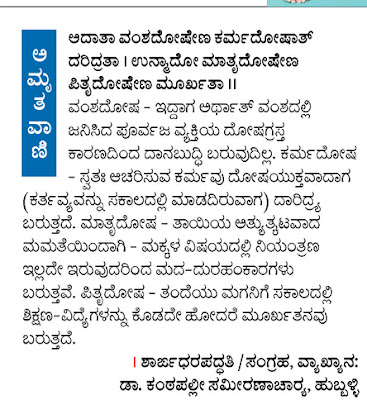Kshamaa is a great virtue to be cultivated by a Yoga Sadhaka.
Interestingly, Kshamaa in Sanskrit can be translated as forgiveness as well as forbearance.
The insistence on Kshamaa comes from the fact that in the absence of Kshamaa we continue to hurt inside, project negative feelings around, and relate to people and situations with anger, vengeance and a sense of victimhood.
My own life and its lessons have taught me that to feel hurt and angry is a perfectly normal feeling for everyone of us. This comes mainly from disappointments and unhappy experiences that went against our own expectations and what we felt was fair to us and what we thought was our entitlement.
In Bhgavadgita, Sri Krishna defines Jnana or wisdom as becoming aware (Anudarshanam) that this life-cycle is fraught with Doshas=defects such as Janma= birth, Mrityu= Death, Jara= Old age, Vyadhi=Disease, Duhkha=Sorrow (BG13.9). Bhagavan also says that contact with this world causes heat and cold, sorrow and pleasure, but all these pass off soon and so we should forbear these experiences (BG 2.14).
So is an essential helpless tolerance of Life's difficulties and pains the only way to truth? What is our truth? What is our true nature? When we pursue the path of Atma Darshan = Awareness of our true eternal nature, we come to realise that our essential nature is an Inner bliss and contentment that cannot be shaken or broken by any external situation or interaction.
Atman is of the nature of eternal bliss. But we are unaware of that. Therefore we identify ourselves with pain and hurt, we identify ourselves with the body and mind and become vulnerable to external experiences with people, things and situations. This bondage should be broken if we want truly to cultivate Kshama.
My favourite source of wisdom and Motivation is the Srimad Bhagavadgita. Sri Krishna defines Yoga as Duhkha-Samyoga-Viyoga (BG6.23)
yasmin sthito na duḥkhena
guruṇāpi vicālyate
taṁ vidyād duḥkha-saṁyoga-
viyogaṁ yoga-saṁjñitam (BG 6.23)
Being situated in such a position, which is defined as Yoga, one is never shaken, even in the midst of greatest difficulty. This indeed is actual freedom from all miseries arising from material contact.
So breaking free of hurt and victimhood by stopping my dependence on external sources of pleasure and joy is the path to Yoga.
As long as I do not have this mindset, I will be hurt and unhappy. I will have expectations which beget disappointments. And the cycle will be eternal.
I cannot use forgiveness as a bargaining tactic in relationships. I have to forgive everyone everything every time because I can see the external cover of body and mind reacting with their own tendencies but I am established in my eternal nature of bliss.
Atma Darshan is the key to forgiveness. Those who hurt others are unaware. Those who feel hurt are also unaware of their own inner joy. We are all sailing in the same boat of worldly existence. We need to break free within ourselves and find that inner joy and peace.
Then and then alone will we be able to forgive like the Buddha.


